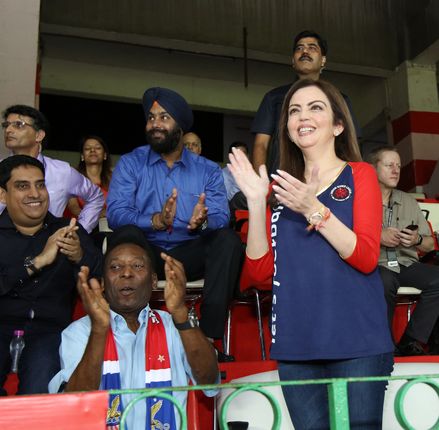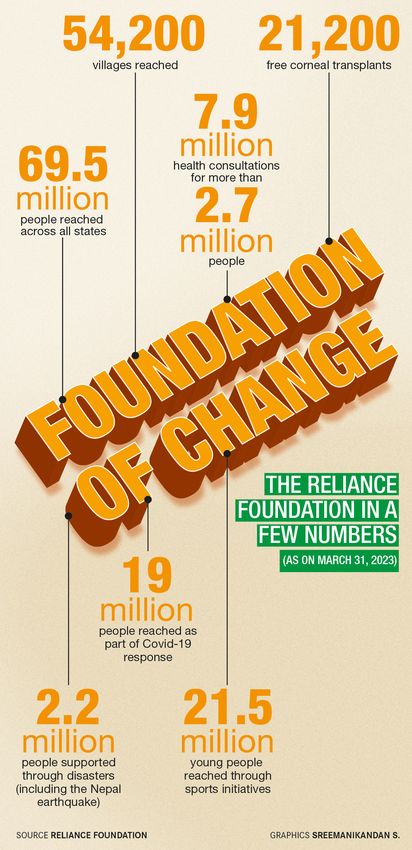Nita Ambani once famously said, “As Indian women, we are always balancing work, life, home, etc. It is important to know that while juggling rubber balls and glass balls, the former may bounce back when you miss, but the glass balls crack if you let them fall. So prioritise, prioritise, prioritise.”
In the last three years, she has been aggressively playing the prioritising game, often trading her “quiet and leisurely life” in Gujarat’s Jamnagar with Mumbai’s fast life, while overseeing the launch of the Nita Mukesh Ambani Cultural Centre (NMACC) even as she manages motherly and grandmotherly duties.
“Add to that, I am also a dog mother,” she says with a glint in her eyes as we meet her at the NMACC for an interview. “My son Anant rescues dogs; he has 5,000 stray dogs, but I have only one who is my family and we call him Happy.”
Happy is the golden retriever who was the ring-bearer when Ambani’s younger son Anant got engaged to Radhika Merchant earlier this year at the family’s residence, Antilia, in South Bombay. In Jamnagar, Anant is involved in running the Elephant Rescue and Rehabilitation Centre, a zoo that will be built on around 280 acres close to the company’s refinery and petrochemicals project.
“I always feel children learn from whatever they observe around them, and given that both Mukesh and I share the same values, I think our children have imbibed these values and continue to live by them, which is very important,” says Nita.
Mid-conversation, she pauses to read out a message her sister-in-law, Mukesh Ambani’s sister Deepti Salgaonkar, had sent her a day earlier, when Deepti visited Nita’s daughter Isha at Antilia. A note of appreciation, Deepti’s message said Isha was “bang on in attending to her kids and dispensing her motherly duties”. “She took them to the temple for evening prayers and sang the same shlokas and prayers you used to sing to her and your boys. I could see how effortlessly she has been passing on the values you have taught her, and she is acing it,” reads Nita from the text message. “You see, I was so touched. It is like, somewhere, we have done something right.”
Sougata Ray, professor of strategy and entrepreneurship (practice) at Indian School of Business, Hyderabad, says Nita has been the face of a more humane Reliance. “She has given it an image-lift, brought in positive vibes and helped in doing away with the negative image that the group was associated with―that of being a cutthroat business family which is more into making money and not making enough contributions to society,” says Ray.
In the last 15 years, he adds, Nita has championed causes in arts, culture, education, sports and health. “Unlike the Tatas and the Birlas, the Ambani family was never known for their contributions to other areas,” says Ray. “Nita started with the making of the Mumbai IPL team and getting aggressively into sports. She went on to become a member of the International Olympic Committee and the Global Athletic Association. She then took over the promotion of football and founded the philanthropic arm Reliance Foundation. From promoting education at the Jio Institute to establishing cultural spaces, Nita has been a leader. She carries herself with grace and charm, and has rarely ever been mired in controversies. She is literally there on the ground, and makes sure her presence gets imprinted on the minds of the people. Earlier the Ambanis were never this ‘seen’.”
Nita is the owner of Mumbai Indians, founder chairperson of Reliance Foundation as well as Football Sports Development Ltd, which launched the Indian Super League, and the head of the Education and Sports for All initiative for children. She is also the first Indian woman to be elected as a member of the International Olympic Committee, and the first Indian to be elected as an honorary trustee of the board of the Metropolitan Museum of Art, New York.
An executive working closely with her marvelled at how “involved she is with everything” and how she goes through even “the minutest details”. Members of her inner circle say their ‘Bhabhi’ has “razor-sharp memory”. “It kind of runs in the family,” says one of them. “All of them are personally involved in everything and know what is happening hands on.”
A friend who has known Nita since the 1990s says she still gets “the customary box of mithai on Diwali and another one of Kesar mangoes from their orchards in Jamnagar” even though the two have not spoken for decades now.
Malavika Sangghvi, a Mumbai-based columnist and author who has known Nita and Mukesh since the 1980s, says Nita is “extremely observant, with great emotional intelligence. This means she can pick up even the subtlest and slightest of emotions in a person.”
Malavika recalled an incident during “a very glamorous dinner” more than 20 years ago. The venue was a famous hostess’s home in Juhu, and both she and Nita were guests. “I had gone alone and Nita, of course, had come with Mukesh. After we had greeted each other and gone our different ways in the crowd, I suddenly found Nita by my side, looking at me with great concern. Someone from my past had entered the room, and she thought I would be awkward meeting that person. And so, unasked and with great consideration, she had come to be by my side,” says Malavika. “She squeezed my hand and whispered, ‘X has just arrived. Will you be OK?’ I will never forget that.”
Once, she and Nita planned a trip to New York with their children―all under 10 at the time. The idea was to spend a week visiting the Central Park and other landmarks in the city. Afterwards, they would leave the children with their parents and trusted staff, so that the two of them could spend a week of rest and rejuvenation at a well-known institute in another city.
“But, come the evening before our travel, and I realised that I just didn’t have the heart to leave my son and go away,” says Malavika. “I was in a quandary. I worried all night on how to tell Nita that I would be backing out. But, the next morning, to my great relief, when I tentatively broached the subject to her, she admitted that she had had the exact same thought [of not wanting to leave the children behind] and had worried about how to break the news to me. After a hearty laugh of relief, we both decided to follow our hearts, abandon our plans and spend time with our kids―with absolutely no regrets!”
Those who know Nita up close refer to her as a perfectionist who does not like sloppiness, tardiness or time-wasting idle talk. “She expects those she engages with to be focused and prepared like herself. Her attention wanes if she does not receive someone’s 100 per cent at a meeting,” says Malavika. “She is an old-school girl when it comes to moral values. Any show of vulgarity or a departure from family values, especially if it involves disrespect to women, gets her riled.”
Nita is also a die-hard foodie. The first thing she talks about when it comes to Kochi is the food. “I love the food there. When Kerala Blasters play, it’s like the entire city comes to a standstill and is a huge party. I thought it only happens when Mumbai Indians play at Wankhede, but surely Kerala Blasters beat us hands down,” she says, laughing.
Nita’s interest in arts, especially in dance and drama, has been known ever since she was in college, says director Feroz Abbas Khan, who was her senior in college and auditioned her for plays. Khan recently directed the musical Civilisation to Nation, which opened at the NMACC in Mumbai’s Bandra Kurla Complex.
“It was Feroz who auditioned me for the play Khileyya, and then persuaded my mother to let me act,” says Nita. “Mahendra Joshi, who is no more but was a great creative mind, was the director of the play and Feroz was already a stage actor.”
Feroz recalls Nita as being “the showstopper who simply owned the stage with her presence and won numerous awards for the college in dance competitions”.
Apparently, Nita was not always “this way”, says a source who has known her since the 1990s. “At the time, they [the family] did have the money but not the aura or the cultural status they command today. She has always been very prickly, was overweight at the time, and dressed quite conventionally in salwar kameez, but always had good taste in clothes. I think at some point she decided she needed to lose weight and went through this dramatic change, which in a way was for the good because if you are in the public eye so much, then you want to look your best and she is a beautiful woman. She changed her way of dressing quite markedly and chose contemporary styles and fits.”
According to the source, profits have always been a major concern for the Ambanis. “I wanted to take my granddaughter to watch the upcoming Broadway musical, The Sound of Music, and the ticket prices were prohibitive,” said the source. “They went up to Rs40,000 for the first row and the cheapest ticket where you can watch properly and not as if you are sitting in another country, is for Rs4,000. Right at the back in the 2,000-seat theatre, tickets are priced in the range of Rs1,500 or so, but the view is terrible. So the NMACC, to an extent, seems very elitist. I think this is also a part of a bigger plan. Because then you are going to start censoring shows and decide who can and cannot perform and who falls in line with your way of thinking. The fee structure is already elite. It automatically keeps out anybody who is beyond a certain class. Art should be for the masses. I am more worried about how they are going to start controlling art or the performing arts.”
Sathya Saran, who was editor of Femina in the mid-1990s and has for years known Nita, says the NMACC will be great for art. In every other place, she says, art has died out; nobody has space for art anymore.
“We met at the Bombay Times party,” says Saran. “I was introduced to her by [Times Group director] Samir Jain. She came across as quite down to earth, and was very interested in holding conversations around art. We carried a four- to five-page interview and pictures of her dancing, [and wrote about] how Mukesh met her and wanted to marry her, how she was very rooted to the middle class and had to adjust to a different household. Then, over the years, things changed. But at that time, she was a very humble person.”
At present, Nita is “very excited” about the upcoming session of the IOC executive board in Mumbai in October. “I hope India can impress them,” she says. “Fingers crossed.”




